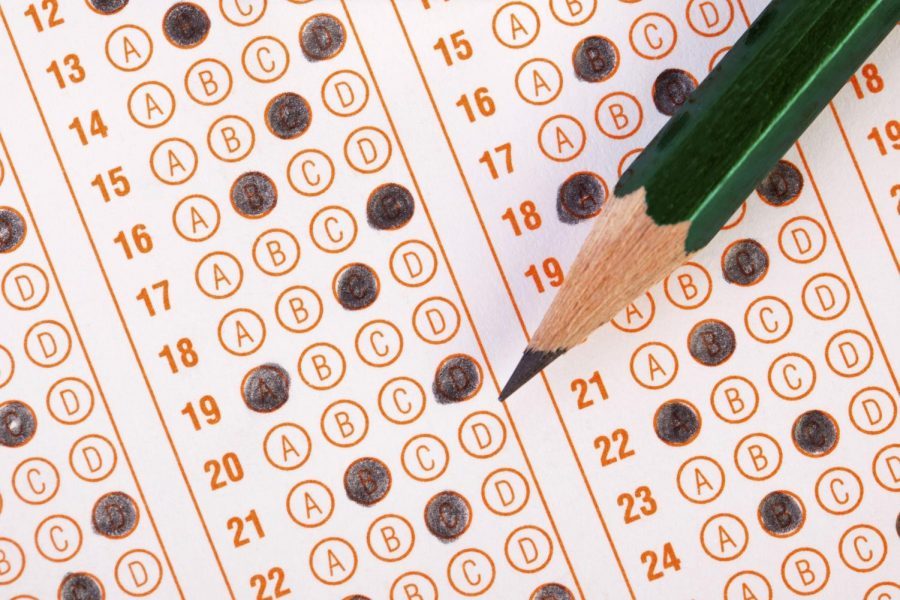OP-ED: Standardized Testing is Below Standard
More Colleges Should Consider Eliminating SATs as an Admissions Criterion
December 2, 2020
In light of the COVID-19 pandemic, over 1,650 accredited colleges and universities have gone ‘test-optional’ this year to accommodate students who were unable to take the SAT or ACT. Some colleges have used this year as an opportunity to experiment with ‘test-free’ admissions, leaving many to wonder if more schools should follow their example.
Mrs. Courtney Kiessling, who teaches SAT/ACT Prep, believes this is an interesting trend.
“I think the test-optional route is the wave of the future, but I don’t know that it will eliminate tests altogether… However, I think we can leave room for the kids who actually do well on these tests to show their knowledge in this way,” Mrs. Kiessling said.
The first SAT was created in 1926 by psychologist Carl Brigham (known then as the “Scholastic Aptitude Test”) and was derived from the intelligence tests given to soldiers in World War I. Brigham was involved with the military tests as well. But, the SAT is, historically, mired in controversy.
In his book A Study of American Intelligence, published in 1923, Brigham stated that he created the tests in order to prove that minorities were “genetically ineducable.”
According to the Class of 2020 SAT Suite Annual Report, 2,198,460 students took the SAT; since the report is based on the series of tests beginning with August 2019, and ending with June 2020, the effect of COVID-19 is not as represented. The mean score for white students was 1104, while Black/African American and Hispanic/Latino students scored 927 and 969 on average. Some have questioned whether the material or questions on the exam are skewed to favor White students. There is an obvious racial disparity in scores, and the SAT’s have long been criticized for the correlation in scores and socioeconomic status. Statistically, minority families have lower median incomes and higher poverty rates overall.
This correlation between socioeconomic status and scoring can be explained by several factors. For one, the SAT is quite pricey, and while fee waivers allow students to take the SAT free of cost, not everyone can afford to take the test more than once. According to CollegeBoard, “Research shows that 2 out of 3 students in the class of 2018, a total of 63%, increased their SAT score by taking the test more than once.”
Tutoring can also present an obstacle to those less fortunate. According to tutors.com, the average cost for SAT tutoring is $70 per hour. Tutoring is proven to have a significant impact on test scores. Another explanation is the incongruity between states on expenditures on education, for example, New York spends the most relative to the rest of the country, totaling $25,288 per pupil, while other states spend significantly less; Arizona spends $7,421 per pupil.
Kiessling agrees.
“These are tests that can be drilled and taught. So a tutor, a private company, or a course like the one that I teach here at PMHS are going to give kids an advantage. If you don’t have the financial means to hire a tutor or the room in your schedule to take an extra class like my elective, then I would have to say that there is probably a disadvantage there,”Mrs. Kiessling said.
Although studies suggest there is a correlation between SAT scores and future success, researchers say the largest factor is high school GPA.
Kiessling remarked, “Many of our bright students perform well on these tests and they deserve praise for it. However, I also know some very bright and hard-working students whose test scores don’t always match their ability.”
Colleges should work on making their admissions process more diverse, standardized testing should only play a supplemental or auxiliary role in exhibiting a student’s ability, serving only to benefit the student. Students would benefit from exploring other means of displaying their talent, activities outside of the classroom that may not even be academic. Colleges present requisites and a mold of a certain type of student that they want those applying to fit into, yet they profess that they sincerely want is variety in their students. If more colleges would take after the same initiative as, say, the University of California, which has decided to go completely test-free this year, it could have a significant benefit to society overall. The subversion of the influence of the SAT would allow more access to higher education for those with fewer academic opportunities.




